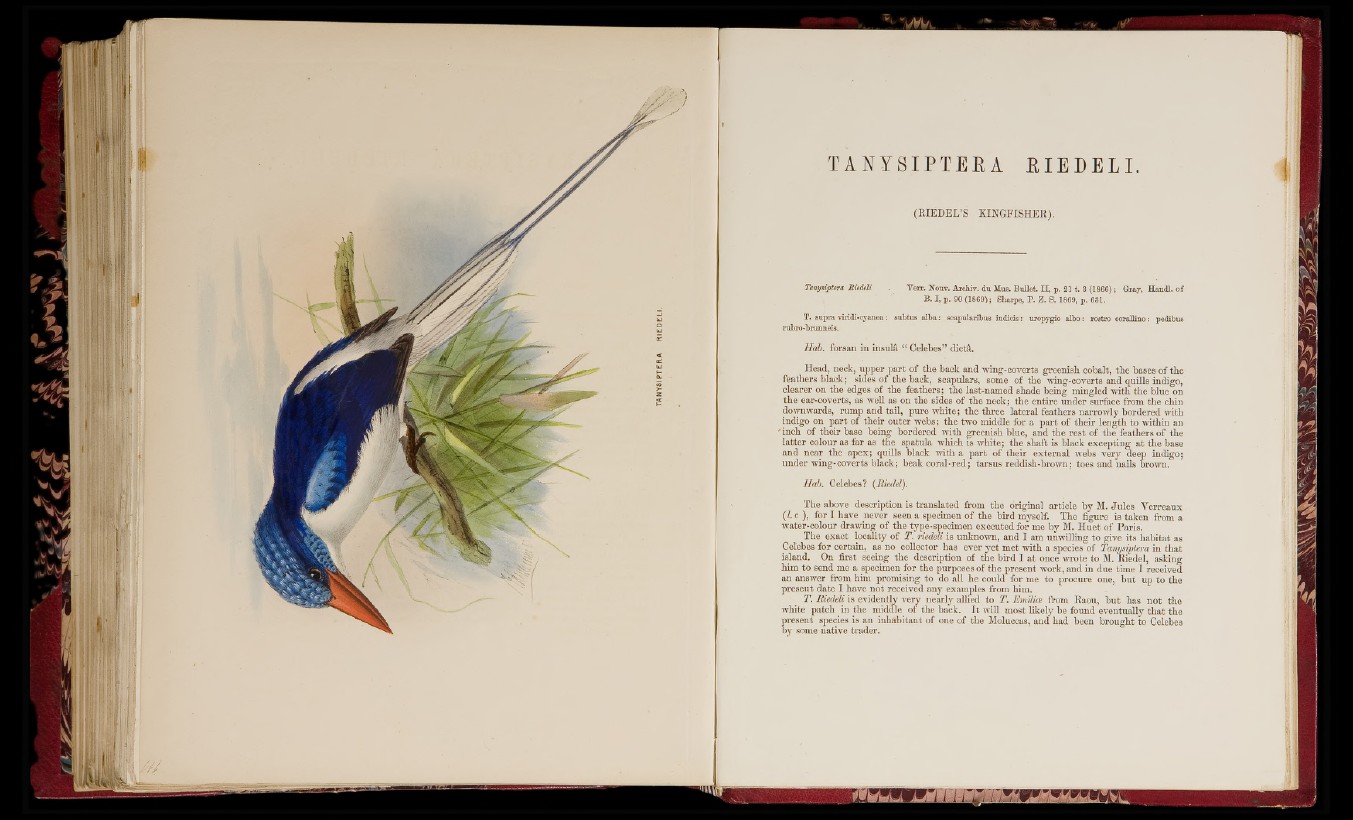
■ h% V',
i i «
T A N Y S I P T E R A R I E D E L I ,
(E IE D E L ’S K IN G F ISH E R ).
Tanysiptera Riedeli . Vorr. Nouv. Archiv. du Mus. Bullet. II, p. 21 t. 3 (1866); Gray, Haudl. of
B. I, p. 90 (1869); Sharpe, P. Z. S. 1869, p. 631.
T. supra viridi-cyanea: subtus alha: scapularibus iudicis: uropygio albo: roitro corallino: pedibus
Tubro-brunneis.
Hah. forsan in insula “ Celebes” dicta.
Head, neck, u pper p a rt o f the back and wing-coverts gi’eenish cobalt, th e bases o f th e
feathers b lack ; sides o f tbe back, scapulars, some o f the wing-coverts and quills indigo,
clearer on th e edges o f the feathers; th e last-named shade being mingled with the blue on
th e ear-coverts, as weR as on th e sides o f th e neck; the en tire u nder surface from th e chin
downwards, rump and tail, p ure white; th e th re e late ra l feathers n arrow ly bordered irith
indigo on p a rt o f tb eir o u ter webs; the two middle for a p a rt o f th e ir len g th to within an
' inch o f theil’ base being bordered ivith gi’eenish blue, and the r e s t o f the feathers o f the
la tte r colour as far as the spatula which is white; th e shaft is black excepting a t th e base
and n e a r the apex; quills black with a p a rt o f th eir e x te rn a l webs v e ry deep indigo;
u nder iving-coverts black; beak co ra l-re d ; tarsu s reddish-brown; toes and nails brown.
Hah. Celebes? {Riedel).
e rreau x
from a
The above description is tran sla ted from th e original article b y M. Ju le s
{l.c ), for I have never seen a specimen o f the bird myself. The figure is taken
water-colour drawing o f tbe type-specimen executed for me b y M. H u e t o f Paris.
The exact locality o f T. riedeli is unknown, and I am unwilling to give its h ab ita t as
Celebes for certain, as no collector has ever y e t m et w ith a species of Tanysiptera in th at
island. On first seeing the description o f th e b ird I a t once Avrote to 51. Riedel, asking
h im to send me a specimen for the purposes o f the p resen t work, and in due time I received
an ansAver from him promising to do all he could for me to p rocure one, b u t up to the
p resent d a te I have n o t receiA'ed any examples from him.
T . Riedeli is evidently very n early allied to T. Emilies from R,aou, b u t has n o t the
Avhite patch in the middle o f the back. I t will most likely be found eventually th a t the
p resent species is an in h ab itan t o f one o f the Aloluccas, aud had been b ro u g h t to Celebes
by some native trad er.